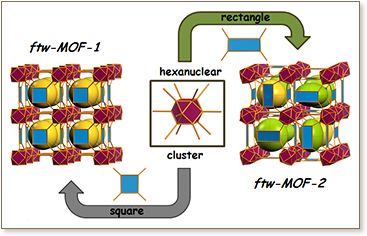

 A series of highly porous MOFs were deliberately targeted to contain a 12-connected rare earth hexanuclear cluster and quadrangular tetracarboxylate ligands. The resultant MOFs have an underlying topology of ftw, and are thus (4,12)-c ftw-MOFs. This targeted rare earth ftw-MOF platform offers the potential to assess the effect of pore functionality and size, via ligand functionalization and/or expansion, on the adsorption properties of relevant gases. Examination of the gas adsorption properties of these compounds showed that the ftw-MOF-2 analogues, constructed from rigid ligands with a phenyl, naphthyl, or anthracene core exhibited a relatively high degree of porosity. The specific surface areas and pore volumes of these analogs are amongst the highest reported for RE-based MOFs. Further studies revealed that the Y-ftw-MOF-2 shows promise as a storage medium for methane (CH4) at high pressures. Furthermore, Y-ftw-MOF-2 shows potential as a separation agent for the selective removal of normal butane (n-C4H10) and propane (C3H8) from natural gas (NG) as well as interesting properties for the selective separation of n-C4H10 from C3H8 or isobutane (iso-C4H10).
A series of highly porous MOFs were deliberately targeted to contain a 12-connected rare earth hexanuclear cluster and quadrangular tetracarboxylate ligands. The resultant MOFs have an underlying topology of ftw, and are thus (4,12)-c ftw-MOFs. This targeted rare earth ftw-MOF platform offers the potential to assess the effect of pore functionality and size, via ligand functionalization and/or expansion, on the adsorption properties of relevant gases. Examination of the gas adsorption properties of these compounds showed that the ftw-MOF-2 analogues, constructed from rigid ligands with a phenyl, naphthyl, or anthracene core exhibited a relatively high degree of porosity. The specific surface areas and pore volumes of these analogs are amongst the highest reported for RE-based MOFs. Further studies revealed that the Y-ftw-MOF-2 shows promise as a storage medium for methane (CH4) at high pressures. Furthermore, Y-ftw-MOF-2 shows potential as a separation agent for the selective removal of normal butane (n-C4H10) and propane (C3H8) from natural gas (NG) as well as interesting properties for the selective separation of n-C4H10 from C3H8 or isobutane (iso-C4H10).